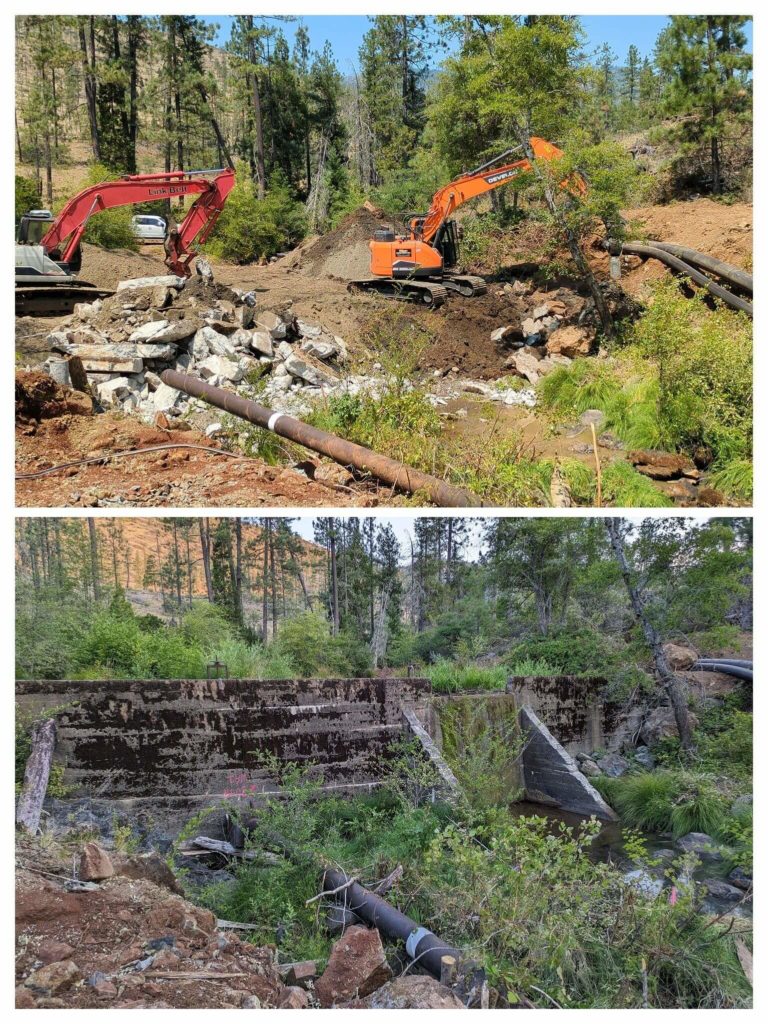Oct. 4, 2023
FOR IMMEDIATE RELEASEContacts:Jim McCarthy, WaterWatch of Oregon
Steve Soesbe, Siskiyou Field InstituteScott Wright, River Design Group
Second Rogue Basin Dam Removal Project in One Year Nears Completion Collaborative effort in Illinois sub-basin benefits salmon and steelhead, increases resiliency to climate change.
Selma, Oregon — Work crews have finished demolition of a 13-foot high, 70-foot wide concrete diversion dam as part of a larger collaborative effort to restore access to habitat for native salmon and steelhead in Takelma Creek, part of the key spawning sub-basin of Deer Creek, itself part of the Illinois River sub-basin of the Rogue River.
Takelma Creek Dam, listed on the 2019 Statewide Fish Passage Barrier Priority List by the Oregon Department of Fish and Wildlife (ODFW) under its former name Squaw Creek Dam, becomes the second priority fish-impeding dam — after the previously announced Lovelace Dam removal in the Applegate sub-basin — to be removed from the Rogue Basin this summer. The multi-faceted project opened access to approximately 3.5 miles of formerly blocked spawning and rearing habitat for salmon and steelhead, replaced the dam’s water diversion function with a fish-friendly, screened, and metered gravity diversion, repaired or partially replaced a leaky water delivery pipe, removed a fish blocking culvert on the Illinois River Road and replaced it with a safer, fish friendly culvert, removed a fish-blocking logging road culvert and replaced it with a fish friendly low-water crossing, and removed a derelict logging road culvert that had long ago washed away and lodged in the bed of Takelma Creek.The project represents one of the many restoration projects in Oregon accelerated thanks to an ODFW grant awarded out of the $8 million in Drought Funds appropriated to fish passage improvement projects during the 2022 legislative session. The project’s road-stream improvement elements also received early major funding from the U.S. Forest Service under authority granted by recently-passed provisions in federal law championed by Senator Ron Wyden (D—Oregon). Takelma Creek is now entirely free-flowing at the former diversion dam site for the first time in at least 70 years. Prior to the commencement of in-water work, the Bureau of Land Management (BLM) led fish salvage operations at the site.
“This is great news for salmon and steelhead, and the many people who love the Illinois River,” said Jim McCarthy, Southern Oregon program director for WaterWatch of Oregon. “The accelerated pace of river restoration in this area is a great credit to the many partners who came together to get the work done, and demonstrates the need to maintain the federal and state programs that make these projects possible.”
State and federal agencies have identified the Deer Creek sub-basin, and improving access to quality fish habitat in its upper reaches, as important to the recovery of Southern Oregon/Northern California Coast Coho salmon, listed as threatened under the Endangered Species Act (ESA). In addition to Coho salmon, Takelma Creek provides spawning and rearing habitat for winter steelhead and cutthroat trout.
“This project is a strong collaboration between Siskiyou Field Institute as the private landowner, agencies, and non-profit organizations working towards the shared goals of improving fish passage, upgrading water supply infrastructure, and improving our rural road network,” said Steve Soesbe, executive director for Siskiyou Field Institute. “This project also offers tremendous educational opportunities for our program participants to better understand the larger benefits of dam removal on local watersheds.”
“As an avid steelhead fisherman raised fishing on the Illinois in Josephine County, it is deeply satisfying to be a part of this collaborative effort to restore salmon and steelhead to this beautiful stretch of creek,” said Scott Wright, principal engineer for River Design Group and lead engineer and project manager for the project. “Removing these barriers creates an unhindered pathway for salmon and steelhead between the ocean and prime freshwater spawning and nursery habitat, and increases this watershed’s overall resiliency against the harms of climate change.”
WaterWatch previously secured a removal agreement for the dam with the private landowner, Siskiyou Field Institute, which ensured removal at no cost to them. The group then initially partnered with the Rogue Basin Partnership and ODFW to secure the approximately $1.1 million in funding necessary for the project. Rogue Basin Partnership secured $15,644 in technical assistance funding from the Resources Legacy Fund. U.S. Forest Service provided significant funding towards removal and replacement of fish-blocking culverts. Additional funding partners include ODFW, U.S. Fish and Wildlife Service Partners for Fish and Wildlife Program, and PacifiCorp. River Design Group provided survey, design, project management, and construction oversight services. River Design Group, U.S. Fish and Wildlife Service, and BLM provided permitting services for this project. Grants Pass-based stream restoration contractors Dietrich Construction, LLC performed the dam demolition, new fish-friendly diversion installation, water pipeline work, culvert replacements, and stream restoration.
Click here for before and after removal images of the Taklema Barrier Project courtesy of River Design Group.


